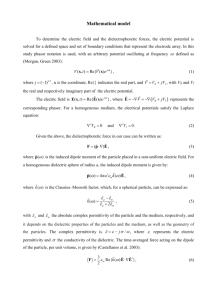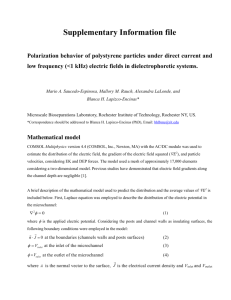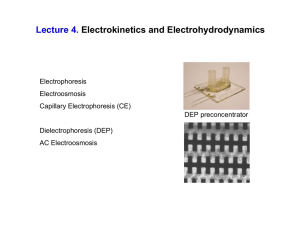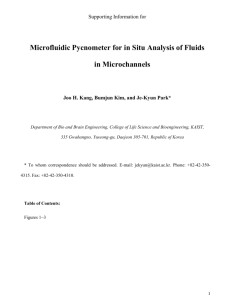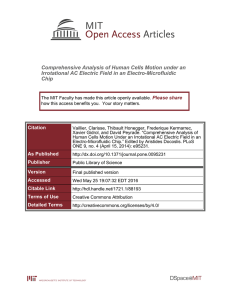Biological cell separation using dielectrophoresis in a microfluidic device
advertisement
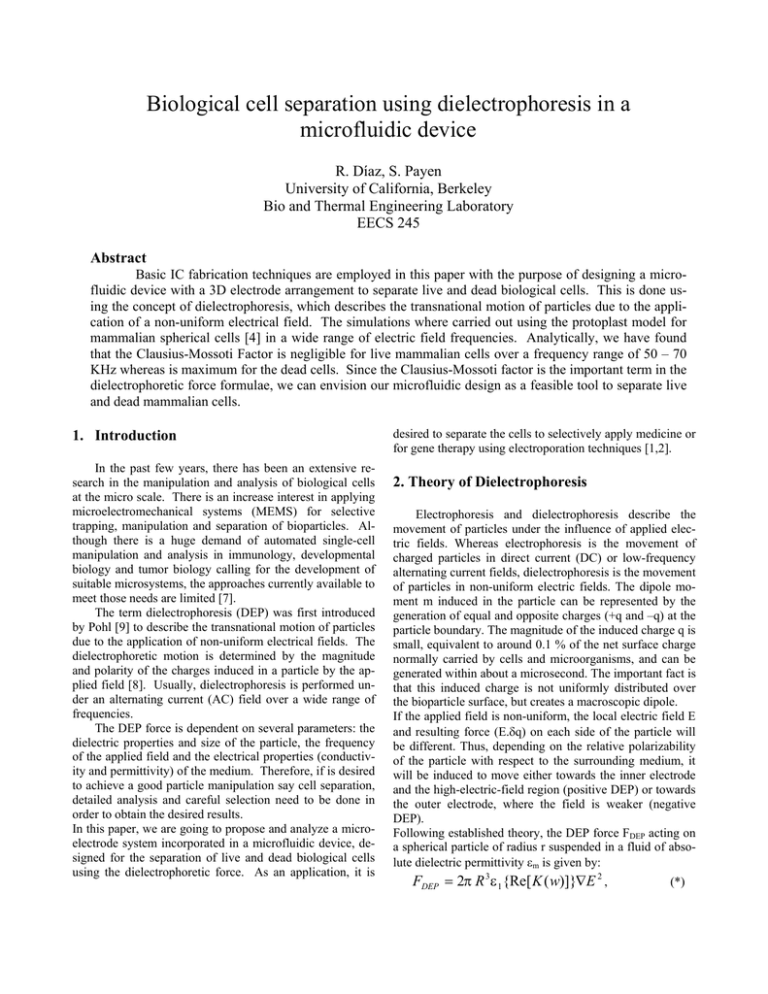
Biological cell separation using dielectrophoresis in a
microfluidic device
R. Díaz, S. Payen
University of California, Berkeley
Bio and Thermal Engineering Laboratory
EECS 245
Abstract
Basic IC fabrication techniques are employed in this paper with the purpose of designing a microfluidic device with a 3D electrode arrangement to separate live and dead biological cells. This is done using the concept of dielectrophoresis, which describes the transnational motion of particles due to the application of a non-uniform electrical field. The simulations where carried out using the protoplast model for
mammalian spherical cells [4] in a wide range of electric field frequencies. Analytically, we have found
that the Clausius-Mossoti Factor is negligible for live mammalian cells over a frequency range of 50 – 70
KHz whereas is maximum for the dead cells. Since the Clausius-Mossoti factor is the important term in the
dielectrophoretic force formulae, we can envision our microfluidic design as a feasible tool to separate live
and dead mammalian cells.
1. Introduction
In the past few years, there has been an extensive research in the manipulation and analysis of biological cells
at the micro scale. There is an increase interest in applying
microelectromechanical systems (MEMS) for selective
trapping, manipulation and separation of bioparticles. Although there is a huge demand of automated single-cell
manipulation and analysis in immunology, developmental
biology and tumor biology calling for the development of
suitable microsystems, the approaches currently available to
meet those needs are limited [7].
The term dielectrophoresis (DEP) was first introduced
by Pohl [9] to describe the transnational motion of particles
due to the application of non-uniform electrical fields. The
dielectrophoretic motion is determined by the magnitude
and polarity of the charges induced in a particle by the applied field [8]. Usually, dielectrophoresis is performed under an alternating current (AC) field over a wide range of
frequencies.
The DEP force is dependent on several parameters: the
dielectric properties and size of the particle, the frequency
of the applied field and the electrical properties (conductivity and permittivity) of the medium. Therefore, if is desired
to achieve a good particle manipulation say cell separation,
detailed analysis and careful selection need to be done in
order to obtain the desired results.
In this paper, we are going to propose and analyze a microelectrode system incorporated in a microfluidic device, designed for the separation of live and dead biological cells
using the dielectrophoretic force. As an application, it is
desired to separate the cells to selectively apply medicine or
for gene therapy using electroporation techniques [1,2].
2. Theory of Dielectrophoresis
Electrophoresis and dielectrophoresis describe the
movement of particles under the influence of applied electric fields. Whereas electrophoresis is the movement of
charged particles in direct current (DC) or low-frequency
alternating current fields, dielectrophoresis is the movement
of particles in non-uniform electric fields. The dipole moment m induced in the particle can be represented by the
generation of equal and opposite charges (+q and –q) at the
particle boundary. The magnitude of the induced charge q is
small, equivalent to around 0.1 % of the net surface charge
normally carried by cells and microorganisms, and can be
generated within about a microsecond. The important fact is
that this induced charge is not uniformly distributed over
the bioparticle surface, but creates a macroscopic dipole.
If the applied field is non-uniform, the local electric field E
and resulting force (E.δq) on each side of the particle will
be different. Thus, depending on the relative polarizability
of the particle with respect to the surrounding medium, it
will be induced to move either towards the inner electrode
and the high-electric-field region (positive DEP) or towards
the outer electrode, where the field is weaker (negative
DEP).
Following established theory, the DEP force FDEP acting on
a spherical particle of radius r suspended in a fluid of absolute dielectric permittivity εm is given by:
FDEP = 2π R 3ε 1{Re[ K ( w)]}∇E 2 ,
(*)
where Re[K(w)] is the Clausius-Mossoti function and determines the effective polarizability of the particle and the
factor ∇E2 is proportional to the gradient and the strength of
the applied electric field. The polarizability parameter
Re[K(w)] varies as a function of the frequency of the applied field and, depending on the dielectric properties of the
particle and the surrounding medium, can theoretically have
a value between +1.0 and –0.5. The value for Re[K(w)] at
frequencies below 1kHz is determined largely by polarizations associated with particle surface charge. While increasing frequency, first the effective conductivity and second the effective permeability are the dominant contributing factors. A positive value for Re[K(w)] leads to an induced dipole moment aligned with the applied field and to a
positive DEP force. A negative value for Re[K(w)] results
in an induced dipole moment aligned against the field and
produces a negative DEP. The fact that the field appears as
∇E2 in the equation of the DEP force indicates that reversing the polarity of the applied voltage does not reverse the
DEP force. AC voltages can therefore be employed and, for
a wide range of applied frequencies (typically 500Hz to
50MHz), the dielectric properties of the particle, as embodied in the parameter Re[K(w)], can be fully exploited.
The advantages of using microelectrodes
The advantages to be gained by reducing the scale of the
electrode design can be illustrated using the example of the
spherical electrodes for the case of a particle located onetenth of the distance from the inner to the outer electrode
[12]. For a 100-fold reduction of electrode size, a 1000-fold
reduction of operating voltage will therefore produce the
same DEP force on a particle in the same relative location.
In addition to the practical advantage of being able to use
lower operating voltages for a given desired DEP force,
there is also a significant reduction in electrical heating and
electrochemical effects. The energy deposition form the
field is proportional to σE2, where σ is the conductivity of
the suspending fluid. In the example just given, for a 100fold reduction of electrode scale, because there is a ten-fold
reduction in the applied electric field strength, the electrical
heating is reduced 100-fold. In addition, as the surface area
of the electrodes in contact with the fluid is decreased, surface electrochemical processes are reduced.
3. Test Structure
The test structure will be composed of two layers (bottom
layer and top layer) that are going to be bonded together to
form a microfluidic channel with a 3D electrode structure.
The fabrication cross sections are depicted on figure 1.
Both layers are going to undergo almost the same fabrication process with one difference, for the bottom layer we
are going to use a single crystal silicon wafer (SCS) and for
the top layer we are going to use a glass wafer. The glass
wafer for the top layer was chosen to gain visual contact
while the micro device is in operation.
The bottom layer fabrication process consists on the deposition and patterning of a 4 µm layer of silicon nitride (Si3N4)
on the silicon wafer. The pattern on the Si3N4 is going to be
2 µm deep and it will be used to deposit the 3 µm wide
platinum (Pt) electrodes by employing the liftoff technique
(see Fig. 1a). The arrangement of the electrodes is going to
be identical on both layers to achieve the desired electric
field around the cells.
Figure 1: Micro fabrication cross-sections.
Subsequently, a 25 µm layer of negative photoresist (SU-8)
is going to be deposited and patterned to form the walls of
the microchannel, which are going to be 200 µm apart (see
fig, 1b). SU-8 was chosen because of the ease to deal with
and because of the good isolation properties. The top layer
is going to undergo the same process as the bottom layer
but with a glass wafer and without the SU-8 walls. The two
layers are going to be bonded together carefully to achieve
symmetry using NEA 121, Norland Products (see fig. 1c).
Wells will be strategically etched on the SU-8 to simplify
the gluing process (not shown above).
The operation of the microfluidic device is simple. We are
going to employ figure 2 to explain the details of the test
structure. The cells will be injected from a syringe pump
gauge 18 using a 1.5 mm diameter plastic tube that is going
to be glued to the wafer in section 1. The cells are going to
flow through section A until they arrive at section B where
the electrodes are going to centralize the cells to the middle
of the microchannel [7]. The dielectrophoretic forces
caused by the gradient of the electric field in the out of
plane direction are canceled because of the electrode symmetry arrangement. The actual cell separation is occurring
at section C. A non-uniform electric field is chosen such
that the dead cells are affected by a high positive dielectrophoretic force while the live cells are not affected or partially affected by a weak negative dielectrophoretic force.
The differences in dielectric properties of the cells allow us
to perform this. The live cells are going to continue an unaffected straight path through section D and the dead cells
are going to be forced to take the path towards section E
where they are being collected.
From [4], we found that the formula for the ClausiusMossotti function is the following:
K ( w) = −
w 2 (τ 1τ m − τ cτ m* ) + jw(τ m* − τ 1 − τ m ) − 1
w 2 (2τ 1τ m + τ cτ m* ) − jw(τ m* + 2τ 1 + τ m ) − 2
The quantities cm and R are the effective capacitance of the
membrane and the radius of the cell respectively, while
τm=cmR/σc and τc=εc/σc are the time constants where σc is
the electrical conductivity and εc is the electrical permitivity
of the cytoplasm. We suppose that the conductance gm is
negligible (loss-less membrane). Finally the other constants
are τ1=ε1/σ1 and τm*=cmR/σ1.
To model a dead cell, we supposed that its membrane became irreversibly permeable. For this case the ClausiusMossotti function is as follows:
K ( w) =
ε c − ε 1 − j (σ 2 − σ 1 ) / w
ε c + 2ε 1 − j (σ 2 + 2σ 1 ) / w
We choose DI water as very resistive suspension medium.
Its parameters are ε1=78*ε0, σ1=10-3 S/m.
The other model parameters are:
- Cytoplasm: εc=60*ε0, σc=0.5 S/m, R=2.0 µm.
- Loss-less membrane: cm=1.0 µF/cm2, gm=0.
Figure 4 is the result of the numerical simulation for the
Clausius-Mossotti function.
1.2
1.0
Figure 2: Top view of the test structure.
In order for the system to work adequately, some numerical
calculations are needed to find the corresponding frequency
that is going to influence the cells in a desirable way.
The mammalian cell model, which is going to be used, is
the protoplast model [4]. The protoplasts are spherical particles where it is possible to identify a cytoplasm and a lossless membrane (see figure 3).
membrane : cm, gm
R
Cytoplasm:
εc , σc
External medium:
ε1 , σ1
Figure 3: Protoplast model parameters
Re[K(w)]
4. Numerical calculations and results
0.8
0.6
Alive cell
0.4
Dead cell
0.2
0.0
-0.2 0
2
4
6
8
10
-0.4
-0.6
Electric field frequency (Log)
Figure 4: The Clausius-Mossotti function for
dead and alive mammalian cells
It is important to notice that the dielectrophoretic force is
directly proportional to the Clausius-Mossoti function. This
relation is given by equation (*).
Alignment:
Sections B, D and E, from figure 3, allow us to align the
cells and prevent contact between the cells and the walls of
the microfluidic channels. In these sections, we can work
with frequencies around 10 MHz where the ClausiusMossoti factor is the same for dead and alive cells, therefore having similar dielectrophoretic forces.
Separation:
In section C, where the separation is occurring, we want to
work in the region where Re[K(w)] is zero for live cells and
around one for dead cells. In this case, we know that the
dead cells will experience a positive DEP toward the bottom channel (section E), whereas the live cells will not experience any force. We calculated that the desired frequency is around 70 kHz.
Finally, we will work with voltage around 10 volts and
flows around 3500 µm/s, according to reference [7]. However it is important to know that we will need to adjust this
numbers, in order to separate effectively the dead and live
particles.
5. Review
The goal of this paper was to use the technique of dielectrophoresis to separate dead and live mammalian cells. The
theory of DEP is well known but it is not obvious to predict
how DEP will act on mammalian cells because these cells
are complex: they are not simple sphere. A cell is a membrane and a cytoplasm. These two parts play a very important role in the calculation of the Clausius-Mossotti function. To simplify the problem, we used the model of protoplasts for live cells and simple sphere for dead cells. These
assumptions allowed us to graphically represent Re[K(w)]
and then find frequencies where we can expect to separate
alive and dead cells. However, there is always the uncertainty of the theoretical analysis versus the real world. That
is why we need the experimentation of the test structure, to
make sure that our assumptions and simplifications are
valid. If they are not valid, a reevaluation of the theory and
the system is required.
If it works, what can we expect from this device?
If the test structure experimentally works, is evident that
optimization is the next step. There are certain variables
that must be clarified, like how fast can we deliver the separation of cells. Moreover, with what kind of cells this process can be performed. The separation speed is directly proportional to the size of the microfluidic device as well as
the electrodes dimensions and dielectrophoretic force. The
variety of cells in which this process can be performed depends on the dielectric properties of the particles as well as
its size and shape. It is safe to say that a more thorough
analysis should be carried out from a biological and fluid
mechanics point of view.
However, it is possible to foresee a possible application for
this system when coupled with electroporation. Electroporation employs electrical pulses applied across a cell for cell
membrane permeabilization [2]. This technique is commonly used in biotechnology for genetic engineering or
medicine application for cells in a batch. Our system will
be of use for this particular application when the electroporation is performed only on the viable cells and not the dead
cells. This will save a big amount of time when this process
is performed in a continuous basis. In addition, the latest
electroporation techniques are being carried out in chips
fully compatible with the IC fabrication process, making it
favorable for adaptation with our microfluidic system.
6. References
1.
Dev, S.B., et al., Medical applications of electroporation. ARTICLE Practical, 2000. 28(1): p. 206-23.
2.
Huang, Y. and B. Rubinsky, Microfabricated electroporation chip for single cell membrane permeabilization. ARTICLE
Practical, 2001. A89(3): p. 242-9.
3.
Hughes, M.P., R. Pethig, and W. Xiao-Bo, Dielectrophoretic forces on particles in travelling electric fields. ARTICLE
Theoretical or Mathematical, 1996. 29(2): p. 474-82.
4.
Jones, T.B., Book, 1995.
6.
Masuda, S., M. Washizu, and I. Kawabata, Movement of
blood cells in liquid by nonuniform traveling field. ARTICLE
Theoretical or Mathematical, 1988. 24(2): p. 217-22.
7.
Muller, T., et al., A 3-D microelectrode system for handling and caging single cells and particles. ARTICLE
Experimental, 1999. 14(3): p. ARTICLE-Experimental.
8.
Pethig, R. and G.H. Markx, Applications of dielectrophoresis in biotechnology. Trends in Biotechnology, 1997. 15(10):
p. 426-432.
9.
Pohl, H.A., Book, 1978.
10.
Talary, M.S., et al., Electromanipulation and separation
of cells using travelling electric fields. ARTICLE Experimental,
1996. 29(8): p. ARTICLE-Experimental.
11.
Washizu, M., T. Nanba, and S. Masuda. Handling of
biological cells using fluid integrated circuit. in No.88CH2565-0).
1988. Pittsburgh, PA, USA: IEEE.
12.
Markx, G.H. and R. Pethig, Dielectrophoretic Separation of Cells - Continuous Separation. Biotechnology and Bioengineering, 1995. 45(4): p. 337-343.
